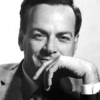Richard P. Feynman

Richard P. Feynman
Richard Phillips Feynmanwas an American theoretical physicist known for his work in the path integral formulation of quantum mechanics, the theory of quantum electrodynamics, and the physics of the superfluidity of supercooled liquid helium, as well as in particle physics for which he proposed the parton model. For his contributions to the development of quantum electrodynamics, Feynman, jointly with Julian Schwinger and Sin-Itiro Tomonaga, received the Nobel Prize in Physics in 1965...
NationalityAmerican
ProfessionPhysicist
Date of Birth11 May 1918
CountryUnited States of America
This attitude of mind - this attitude of uncertainty - is vital to the scientist, and it is this attitude of mind which the student must first acquire. It becomes a habit of thought. Once acquired, we cannot retreat from it anymore.
During the Middle Ages there were all kinds of crazy ideas, such as that a piece of rhinoceros horn would increase potency. Then a method was discovered for separating the ideas - which was to try one to see if it worked, and if it didn't work, to eliminate it. This method became organized, of course, into science.
[Quantum mechanics] describes nature as absurd from the point of view of common sense. And yet it fully agrees with experiment. So I hope you can accept nature as She is - absurd.
Start out understanding religion by saying everything is possibly wrong... As soon as you do that, you start sliding down an edge which is hard to recover from...
Religion is a culture of faith; science is a culture of doubt.
God was invented to explain mystery. God is always invented to explain those things that you do not understand.
Working out another system to replace Newton's laws took a long time because phenomena at the atomic level were quite strange. One had to lose one's common sense in order to perceive what was happening at the atomic level.
With the exception of gravitation and radioactivity, all of the phenomena known to physicists and chemists in 1911 have their ultimate explanation in the laws of quantum electrodynamics.
When I would hear the rabbi tell about some miracle such as a bush whose leaves were shaking but there wasn't any wind, I would try to fit the miracle into the real world and explain it in terms of natural phenomena.
What goes on inside a star is better understood than one might guess from the difficulty of having to look at a little dot of light through a telescope, because we can calculate what the atoms in the stars should do in most circumstances.
We seem gradually to be groping toward an understanding of the world of subatomic particles, but we really do not know how far we have yet to go in this task.
We get the exciting result that the total energy of the universe is zero. Why this should be so is one of the great mysteries - and therefore one of the important questions of physics. After all, what would be the use of studying physics if the mysteries were not the most important things to investigate?
We do not know where to look, or what to look for, when something is memorized. We do not know what it means, or what change there is in the nervous system, when a fact is learned. This is a very important problem which has not been solved at all.
We do not know what the rules of the game are; all we are allowed to do is to watch the playing. Of course, if we watch long enough, we may eventually catch on to a few of the rules. The rules of the game are what we mean by fundamental physics.